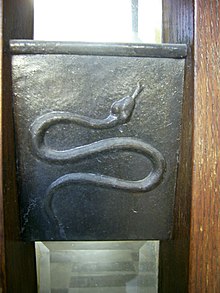Tribe of Dan
[2] Some textual scholars regard the census as being from the Priestly Source, dating it to around the 7th century BC, and more likely to reflect the biases of its authors.
[7][8] The land originally allocated to Dan was a small enclave in the central coastal area of Canaan, between Judah, Benjamin, Ephraim and the Philistines.
[10] Excavations conducted at Tel Dan by David Ilan of the Hebrew Union College show support for the Danites' potential Aegean connections.
Thus their territory in the end lay northeast of that of Naphtali, east of the upper Jordan River, near its eastern sources, and defining the northern extent of the land of the Israelites.
[12] The tribe provided substantial military support for the kingdom in the form of 28,600 soldiers, being considered "experts in war".
A 15th-century Latin chronicle, "Chronicon Holsatiae vetus", found in Gottfried Leibniz's Accessiones historicae (1698), states the Danes were of the Tribe of Dan.
[15] Additionally, proponents of Nordic and British Israelism have made similar claims about descent from the tribe of Dan.
British Israelite authors such as John Cox Gawler and J. H. Allen identified the Tribe of Dan with Denmark.
[16] While another prominent British Israelite author, Edward Hine, took the view that the tribe of Dan had colonized Denmark and Ulster in Ireland.



